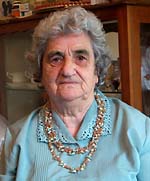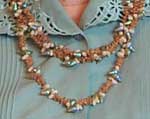I was born on Cape Barren Island. It's only a small island, and very isolated it was when I was growing up in the 30s and 40s. My mother died when I was only three. There were six of us on the island and we were fostered out to our aunties and relations.
Shell necklace maker Dulcie Greeno

I've lived near the sea most of my life. My dad was a fisherman. My husband was a fisherman and both my sons. Often I'd go out on the boat with my husband cray fishing and we'd be anchored off sheltered beaches for the night and we'd go ashore and collect shells.

I miss the sea and the beaches living here [in Launceston]. I wouldn't want to go back to the islands to live but I lived there most of the time as child. It was lovely. It was free. We lived right near the sea. We'd only have to go across the road, past a house, just a few hundred yards and then on to the beach.
My grandmother used to do shell necklaces and a couple of my aunties. We'd go round with them on the beach and collect shells with them. We had to walk everywhere then. There weren't a lot of vehicles to go around. We used to walk for miles to collect the shells. Mum used to sell them. Dad used to go and help Mum collect the shells because you have to go in the water to get the mareeners. Dad always used to say they were too fiddly for him, these rice shells. He had such big hands.
We used to pick up shells on the beach when we were young, ones with a hole already in them and we used to make necklaces and just wear those around our necks. That's when I started making necklaces really.
I want to try and encourage the younger ones to continue the necklace making. There are a couple who are doing it now. I think it's important because it's a traditional culture from Tasmanian Aboriginal women and I want to see it continue. We're all getting old now and we won't be able to continue with it forever.
Often when we're at the schools [Dulcie and Muriel Maynard go to schools teaching their craft to children], the teachers will use the tiny ones because they're too small for the kids. We only take the bigger shells there for the school children to make a bracelet. They like the bigger shells because they have a bigger needle. I noticed the first time the teachers did the little rice shells they had a hard job finding the right end to string because the ends look the same and they are so small. We have some fun though.
We work out a pattern before we start to make them. Sometimes I've made three or four inches of shells and haven't been satisfied and so I've taken them all off and changed it. I like stringing these small rice shells. The smaller the shells the daintier I think the strings are.
You can pick these mareener shells up on the beach and they are that colour (a greeny blue mother of pearl colour) but we don't use the ones we pick up on the beach because they are too brittle and they lose their colour. Perhaps the earlier Aboriginal people picked them up off the beach like that but I don't really know. I don't know what people used traditionally to clean them. We heard a lot of stories about what the earlier ones used to do but noone knows. There hasn't been a record. I don't think anybody would know.
We still walk for miles on the beach to get the shells. There are a lot of places that you can't get to by car. I don't mind walking because I've been used to it. On the beach you don't think of anything else. We take our lunch and crawl along on our hands and knees to get the shells. But I love it. I love it really.
There's a lot of march flies and you have to spray with aerogard (a fly repellant) Towards the winter time there's a lot of mosquitoes too and you're banging on your hands to try and kill them. But you'd do anything to go and get the shells.
Related
My favourite shell is the mareener (a greeny purple or blue shell with a mother-of-pearl finish when cleaned). In the majority of necklaces I make you'll always find a mareener shell. It's my favourite I suppose because it was my Mum and Dad's favourite shell.
I watched my mother making shell necklaces. She made them apparently before they were too many of us children. There were ten in my family. She made them in earlier times for pocket money helping to feed and clothe us kids. But then she gave it away for a few years, then she moved to Launceston.



